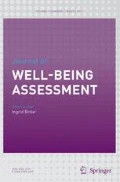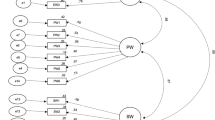Abstract
This research investigates the much-debated factor structure of the 54-item version of Ryff’s (1989) Scales of Psychological Well-being (SPWB). Using two samples (n1 = 573; n2 = 449) of undergraduate university students, we apply confirmatory factor analysis (CFA) along with recently developed exploratory structural equation modeling (ESEM) techniques to evaluate several unidimensional and multidimensional models identified in previous research, as well as a new bifactor model. In a bifactor model, items load directly on both a global and a specific factor; when tested using ESEM, cross-loadings on other specific factors are also permitted and are targeted to be as close to zero as possible. After comparing various ESEM and traditional CFA models, the results indicate that a bifactor model estimated using ESEM provided the best fit to the data. Most items were found to reflect the global factor, but some items failed to reflect the intended specific factor. Thus, the 54-item version of the SPWB appears to be a good measure of overall psychological well-being, but may need refinement as a measure of the intended specific factors, at least among young adults. The benefits of applying ESEM to investigate the factor structure of the SPWB in other populations are discussed.


Similar content being viewed by others
Notes
For completeness, hierarchical 3- and 6-factor CFA models were also estimated. However, these models provided a poorer fit to the data than the corresponding non-hierarchical CFA models. For this reason, and because these models often involve unrealistic assumptions (e.g., Morin et al. 2016; Reise 2012), they are not reported in the Results but are available from the first author upon request.
In the past, some investigators have reported that fit improves in models allowing correlations among the residuals for adjacent items and/or by allowing negatively worded items to load on a method factor (e.g., Springer and Hauser 2006). Due to the complexity of the ESEM models tested here (e.g., 6-bifactor model), we did not use either of these procedures to account for potential method variance. However, inspection of the modification indices provided by Mplus suggested that applications of these procedures would be unlikely to improve model fit substantially. Details regarding these modification indices can be found in Online Resource 2.
References
Abbott, R. A., Ploubidis, G. B., Huppert, F. A., Kuh, D., Wadsworth, M. E., & Croudace, T. J. (2006). Psychometric evaluation and predictive validity of Ryff's psychological well-being items in a UK birth cohort sample of women. Health and Quality of Life Outcomes, 4(1), 76–92.
Allport, G. W. (1961). Pattern and growth in personality. New York, NY: Holt, Rinehart, and Winston.
Aristotle (1985). Nicomachean ethics (T. Irwin, Trans.). Indianapolis, IN: Hackett.
Asparouhov, T., & Muthén, B. (2009). Exploratory structural equation modeling. Structural Equation Modeling, 16, 397–438.
Bandalos, D.L., & Boehm-Kaufman, M.R. (2009). Four common misconceptions in exploratory factor analysis. In. C.E. Lance & R.J. Vandenberg (Eds.), Statistical and methodological myths and urban legends (pp. 61–87). New York: Routledge.
Browne, M. W., & Cudeck, R. (1993). Alternative ways of assessing model fit. In K. A. Bollen & J. S. Long (Eds.), Testing structural equation models (pp. 136–162). Newbury Park, CA: Sage.
Burns, R. A., & Machin, M. A. (2009). Investigating the structural validity of Ryff’s psychological well-being scales across two samples. Social Indicators Research, 93(2), 359–375.
Chen, F. F. (2007). Sensitivity of goodness of fit indexes to lack of measurement invariance. Structural Equation Modeling, 14(3), 464–504.
Clarke, P. J., Marshall, V. W., Ryff, C. D., & Rosenthal, C. J. (2000). Well-being in Canadian seniors: Findings from the Canadian study of health and aging. Canadian Journal on Aging/La Revue Canadienne du Vieillissement, 19(2), 139–159.
Clarke, P. J., Marshall, V. W., Ryff, C. D., & Wheaton, B. (2001). Measuring psychological well-being in the Canadian study of health and aging. International Psychogeriatrics, 13(1), 79–90.
Cronbach, L. J. (1970). Essentials of psychological testing. Macmillan: New York: Macmillan.
Finney, S. J., & DiStefano, C. (2013). Non-normal and categorical data in structural equation modeling. In G. R. Hancock & R. O. Mueller (Eds.), Structural Equation Modeling: A Second Course (2nd ed., pp. 439–492). Greenwich, CO: IAP.
Frankl, V. E., & Lasch, I. (1992). Man’s search for meaning: An introduction to logotherapy. Boston, MA: Beacon Press. (Originally work published 1959).
Gallagher, M. W., Lopez, S. J., & Preacher, K. J. (2009). The hierarchical structure of well- being. Journal of Personality, 77(4), 1025–1050.
Gignac, G. E. (2016). The higher-order model imposes a proportionality constraint: That is why the bifactor model tends to fit better. Intelligence, 55, 57–68.
Guay, F., Morin, A. J., Litalien, D., Valois, P., & Vallerand, R. J. (2015). Application of exploratory structural equation modeling to evaluate the academic motivation scale. The Journal of Experimental Education, 83(1), 51–82.
Howard, J. L., Gagné, M., Morin, A. J., & Forest, J. (2016). Using bifactor exploratory structural equation modeling to test for a continuum structure of motivation. Journal of Management, 1–27.
Hu, L. T., & Bentler, P. M. (1999). Cutoff criteria for fit indexes in covariance structure analysis: Conventional criteria versus new alternatives. Structural Equation Modeling: A Multidisciplinary Journal, 6(1), 1–55.
Kafka, G. J., & Kozma, A. (2002). The construct validity of Ryff's scales of psychological well- being (SPWB) and their relationship to measures of subjective well-being. Social Indicators Research, 57(2), 171–190.
Kam, C. C. S., & Meyer, J. P. (2015). How careless responding and acquiescence response bias can influence construct dimensionality: The case of job satisfaction. Organizational Research Methods, 18(3), 512–541.
Litalien, D., Morin, A. J. S., Gagné, M., Vallerand, R. J., Losier, G. F., & Ryan, R. M. (2017). Evidence of a continuum structure of academic self-determination: A two-study test using a bifactor-ESEM representation of academic motivation. Contemporary Educational Psychology, 51, 67–82.
Marsh, H. W., Hau, K.-T., & Grayson, D. (2005). Goodness of fit evaluation in structural equation modeling. In A. Maydeu-Olivares & J. McArdle (Eds.), Contemporary psychometrics. A Festschrift for Roderick P. McDonald (pp. 275–340). Mahwah NJ: Erlbaum.
Marsh, H. W., Morin, A. J., Parker, P. D., & Kaur, G. (2014). Exploratory structural equation modeling: An integration of the best features of exploratory and confirmatory factor analysis. Annual Review of Clinical Psychology, 10, 85–110.
Maslow, A. H. (1968). Toward a psychology of being. New York: D. Van Nostrand Company.
Morin, A. J. S., Arens, A., & Marsh, H. (2016). A bifactor exploratory structural equation modeling framework for the identification of distinct sources of construct-relevant psychometric multidimensionality. Structural Equation Modeling, 23, 116–139.
Muthén, B., & Asparouhov, T. (2012). Bayesian structural equation modeling: A more flexible representation of substantive theory. Psychological Methods, 17, 313–335.
Muthén, L. K., & Muthén, B. O. (2014). Mplus user’s guide. Los Angeles, CA: Muthén &. Muthén.
Reise, S. P. (2012). The rediscovery of bifactor measurement models. Multivariate Behavioral Research, 47, 667–696.
Rogers, C. R. (1962). The interpersonal relationship: The core of guidance. Harvard Educational Review, 32, 416–429.
Ryan, R. M., & Deci, E. L. (2001). On happiness and human potentials: A review of research on hedonic and eudaimonic well-being. Annual Review of Psychology, 52(1), 141–166.
Ryff, C. D. (1989). Happiness is everything, or is it? Explorations on the meaning of psychological well-being. Journal of Personality and Social Psychology, 57(6), 069–1081.
Ryff, C. D. (2014). Psychological well-being revisited: Advances in the science and practice of eudaimonia. Psychotherapy and Psychosomatics, 83(1), 10–28.
Ryff, C. D., & Keyes, C. L. M. (1995). The structure of psychological well-being revisited. Journal of Personality and Social Psychology, 69(4), 719–727.
Ryff, C. D., & Singer, B. H. (2006). Best news yet on the six-factor model of well-being. Social. Science Research, 35(4), 1103–1119.
Sánchez-Oliva, D., Morin, A. J., Teixeira, P. J., Carraça, E. V., Palmeira, A. L., & Silva, M. N. (2017). A bifactor exploratory structural equation modeling representation of the structure of the basic psychological needs at work scale. Journal of Vocational Behavior, 98, 173–187.
Schwartz, S. J., Waterman, A. S., Vazsonyi, A. T., Zamboanga, B. L., Whitbourne, S. K., Weisskirch, R. S., et al. (2011). The association of well-being with health risk behaviors in college-attending young adults. Applied Developmental Science, 15(1), 20–36.
Springer, K. W., & Hauser, R. M. (2006). An assessment of the construct validity of Ryff’s scales of psychological well-being: Method, mode, and measurement effects. Social Science Research, 35(4), 1080–1102.
Springer, K. W., Hauser, R. M., & Freese, J. (2006). Bad news indeed for Ryff’s six-factor model of well-being. Social Science Research, 35(4), 1120–1131.
Thurstone, L. L. (1945). Multiple factor analysis. Chicago: University of Chicago Press.
Vallerand, R. J., Pelletier, L. G., Blais, M. R., Briere, N. M., Senecal, C., & Vallieres, E. F. (1992). The academic motivation scale: A measure of intrinsic, extrinsic, and amotivation in education. Educational and Psychological Measurement, 52(4), 1003–1017.
van de Schoot, R., Kaplan, D., Denissen, J., Asendorpf, J. B., Neyer, F. J., & van Aken, M. A. G. (2014). A gentle introduction to Bayesian analysis: Applications to developmental research. Child Development, 85, 842–860.
van Dierendonck, D. (2004). The construct validity of Ryff's scales of psychological well-being and its extension with spiritual well-being. Personality and Individual Differences, 36(3), 629–643.
Waterman, A. S. (2011). Eudaimonic identity theory: Identity as self-discovery. In Handbook of Identity Theory and Research (pp. 357–379). New York, NY: Springer.
Wiggins, J. S. (1973). Personality and prediction: Principles of personality assessment. Menlo Park, CA: Addison-Wesley.
Zyphur, M. J., & Oswald, F. L. (2015). Bayesian estimation and inference: A user’s guide. Journal of Management, 41, 390–420.
Acknowledgements
This research was supported by a research grant from the Social Sciences and Humanities Research Council (435-2014-0956) awarded to the second author.
Author information
Authors and Affiliations
Corresponding author
Ethics declarations
Conflict of Interest
On behalf of all authors, the corresponding author states that there is no conflict of interest.
Electronic supplementary material
ESM 1
(PDF 405 kb)
Appendix
Appendix
Rights and permissions
About this article
Cite this article
Espinoza, J.A., Meyer, J.P., Anderson, B.K. et al. Evidence for a Bifactor Structure of the Scales of Psychological Well-Being Using Exploratory Structural Equation Modeling. J well-being assess 2, 21–40 (2018). https://doi.org/10.1007/s41543-018-0008-y
Published:
Issue Date:
DOI: https://doi.org/10.1007/s41543-018-0008-y




